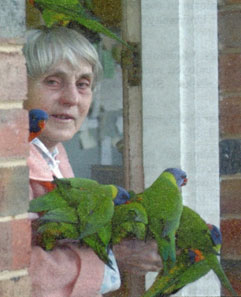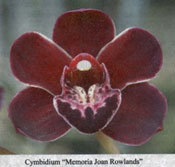1930 ~ 2008
Joan Margaret Bean was born in Palmwoods, Queensland to a fruit farmer and his wife. Joan was the third of four children and attended school in Palmwoods travelling the few kilometres on horseback in her early days.
She was in Brisbane with her mother in 1942 when her mother died suddenly from a heart attack.
Joan’s secondary education commenced at Ipswich Girls Grammar where she was admitted as a boarder. The school was evacuated during the latter stages of the war to a large station homestead near Stanthorpe, where she learned that parts of Queensland can be very cold. The homestead had a large garden which Joan loved exploring and which she found particularly interesting.
After her elder sister married, Joan was then expected to keep house for her father and younger sister while completing her year twelve qualification. She obtained her driving licence at 16, which was normal in country Queensland during and after the war. She used to drive her father’s car to school in Nambour, where she excelled in physics, chemistry, music and several other subjects. She was the only female student completing science subjects in her year 12, but because of the family situation there was no possibility of university study.
In 1952 Joan was offered a position at the Commonwealth Serum Laboratories, Melbourne, (CSL was then part of the Commonwealth Health Department), which is where I got to know her. She was living in various boarding establishments, and riding to work by bicycle. It was here she learned how to handle pathogenic bacteria and viruses. She was determined to continue her education at Melbourne University, and eventually obtained permission from CSL to do so on a part-time basis, making up after normal work for time taken off for lectures. She was the first female employee at CSL to obtain this type of concession.
In 1955 her father visited Melbourne and gave her the deposit on a newly built house in West Brunswick. She set about establishing a garden but because of the clay soil roses were the main planting. Having her own house enabled her to own a Siamese cat, which became the start of a long breeding line which has continued to this day. After moving to North Balwyn she also boarded cats.
Joan left CSL about this time and worked in the Biochemistry Department at Royal Melbourne Hospital, conveniently close to the University. The bicycle remained her usual mode of transport.
We were both members of the Melbourne University Mountaineering Club and enjoyed many outings with that group. We particularly enjoyed rock climbing, but Joan’s small stature restricted her ability to carry a pack for longer walks. She always boasted that she was only 4 feet 8 1/2 inches (1453 cm) high.
Joan became interested in photography, and some of her photographs did well when exhibited at the Melbourne Camera Club and the Melbourne Town Hall.
In 1957, Joan finally agreed to marry me and the wedding was in November of that year. By this time asthma had become quite a problem for her and she retired from the workforce. She became interested in Aboriginal art and artefacts, and became a volunteer at the Melbourne Museum classifying several collections of stone tools and the like. We also joined the Victorian Anthropological Society where Joan became auditor and later treasurer until it finally folded.
We moved to North Balwyn in 1958, a fortunate move as the back-yard of the West Brunswick property was resumed for the Tullamarine Freeway. Joan once again set about establishing a garden. This time it was camellias; we ended up with over 150 plants and it necessitated the purchase of an adjoining property to accommodate them. We joined the Camellia Society, doing well at shows and meetings due to our extensive collection. Many conifers were also planted.
Around 1960 we made trips, to western New South Wales and the Flinders Ranges in South Australia. This fostered an interest in Aboriginal rock art. In 1962 Joan drew my attention to a dotted line on a map between north-west NSW and the Flinders Ranges telling me “that would be a very interesting way to travel to the Flinders”. Letters to stations in the area produced the information and advice that the track was probably not passable by car, but that a four-wheel drive vehicle would be needed.
This led to the purchase of a Land Rover and the beginning of a series of outback trips. We recorded several hundred Aboriginal stone arrangements and other aboriginal sites in five States. We received support and financial assistance from the (then) Australian Institute of Aboriginal Studies and the Potter Foundation. The last research trip was in 1985 after which funding became too difficult to obtain. Joan retained a fondness for that Land Rover.
Joan was always interested in cooking and claimed that I was useless in this regard as I could not even boil water! This was partly true as I often filled the kettle on request but forgot to turn on the switch! Joan was a fine cook and could bake excellent loaves of bread, and even cakes, in a camp oven in the Simpson Desert.
In 1968, Joan suggested that I obtain a pilot licence which could be useful for us visiting friends in the outback. This I did but when she came on her first flight with me she decided to do the same. She had difficulty due to her height (it is not easy to land if you can’t see the runway), but succeeded and even flew aerobatics with one of the best aerobatic pilots at the time. She became part owner of an aerobatic aircraft, but we much preferred Beechcraft Debonair or Bonanza for longer trips.
She rang me at work one day in 1973, and said she wanted to buy a Beechcraft Debonair (which cruises at 150 knots). I told her to ask the bank manager if he would agree – to my surprise he did! Since 1991, as a result of my first heart attack, Joan has been the only pilot when we were using it. Her aviation medical examiner told me recently that she probably loved the aircraft more than she loved me.
Joan loved travelling and we had several overseas trips together. The aircraft led to one of her trips when it became prudent to replace the engine which was showing some internal corrosion. Joan went to the USA to negotiate the purchase of a reconditioned engine and obtain the paperwork for its installation. She also went to India twice on her own, as I was unable to go with her at the time.
Joan became interested in orchids in the 1960’s when someone gave her a plant of Cymbidium Doris, which naturally grew and multiplied as only ‘Doris’ can. We joined the Warringal Orchid Society and received or won plants of various genera. Joan said she would leave these alone and learn to grow cymbidiums “properly”. She was still of course learning, as we all do, when she died.
At various times we were members of Melbourne Eastern Orchid Society, Ringwood Orchid Society, North East Melbourne Orchid Society, Cymbidium Club of South Australia, Victorian Orchid Club, Cymbidium Orchid Society of Victoria and Maribyrnong Orchid Society. Joan planned our orchid breeding activities and one of Joan’s crosses, Cymbidium Eye of the Tiger has been awarded and does well consistently on the show bench. Another cymbidium cross suggested by Joan, I have since registered as Cymbidium Memoria Joan Rowlands.
Joan also had an interest in a variety of plants. For many years she was a member of the Cactus and Succulent Society, and grew a selection of these in a small glasshouse we had purchased and erected. More recently she had become interested in dahlias, and had done some breeding with these. Roses were also an interest and she was a member of the Rose Society.
In addition, visits to Tasmania in the early 1990’s started an interest in ferns, bryophytes and fungi, with memberships of the Fern Society and the Field Naturalists Club of Victoria, the latter for the Botany Group and the Fungi Group. This in turned to membership of Fungimap, an Australia wide fugal mapping scheme. Recent conferences we attended, apart from several in Victoria, have included meetings in New Zealand and in Western Australia.
On the 17th July, 2008, we were returning home after visiting friends at Nar Nar Goon. We were in the Land Rover and I was driving. We joined the highway and just started to speed up when the accident happened. I recovered consciousness some while later and saw flashing lights outside. I was extracted from the wrecked vehicle and flown to hospital. I learned later that we had been hit squarely from behind by a ten tonne truck. Joan had apparently died instantly. Joan had developed osteoporosis and already had a collapsed vertebra, so the impact did the rest. The vehicle was a write-off and it is perhaps appropriate that both Joan and the Land Rover died at the same instant.
In life, Joan had always been terrified of ending up with Alzheimer’s disease or cancer, or of being left a widow. I had given her a bad fright when I had my second heart attack in 2005. She was spared these outcomes and also seeing the destruction of so much of her beloved forest on Black Saturday.
Tribute by Bob Rowlands
A donation has been made to the Australian Orchid Trust Fund by Mr. Bob Rowlands.
AOTF: 3109



